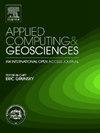Analyzing key controlling factors of shale reservoir heterogeneity in "thin" stratigraphic settings: A deep learning-aided case study of the Wufeng-Longmaxi Formations, Fuyan Syncline, Northern Guizhou
IF 3.2
Q2 COMPUTER SCIENCE, INTERDISCIPLINARY APPLICATIONS
引用次数: 0
Abstract
The Wufeng-Longmaxi Formation shales are key targets for shale gas exploration, but they are often studied as a single stratigraphic unit with limited analysis of internal differences. This study combines traditional geological methods with deep learning to compare the reservoir characteristics of the Wufeng Formation, the first member of the Longmaxi Formation (Long 1), and the second member of the Longmaxi Formation (Long 2), identifying the main controlling factors of differences. We found that: (1) The Wufeng Formation primarily develops siliceous shale lithofacies (S), mixed siliceous shale lithofacies (S-2), and clay siliceous shale lithofacies (S-3). Long 1 develops mixed siliceous shale lithofacies (S-2) and clay siliceous shale lithofacies (S-3), while Long 2 exhibits clay and siliceous mixed shale lithofacies (M-2) and siliceous clay shale lithofacies (CM-1). (2) The YOLO-v8 model demonstrates higher accuracy in shale pore type detection than the YOLO-v10 model, with a maximum mAP of 78.9 %. Using the YOLO-v8 model, it was found that S, S-2, and S-3 lithofacies are dominated by dissolution pores and organic pores with larger specific surface areas and porosities, while CM-1 and M-2 lithofacies are characterized by dissolution pores with smaller specific surface areas and porosities. (3) Based on evaluation indicators such as TOC content, BET surface area, porosity, brittleness index, and gas content, S and S-2 are classified as Class I lithofacies, S-3 as Class II lithofacies, and M-2 and CM-1 as Class III lithofacies. The main controlling factor for the heterogeneity of the shale reservoirs in the study area is lithofacies.
“薄”地层条件下页岩储层非均质性控制因素分析——以黔北扶岩向斜五峰组—龙马溪组为例
五峰组—龙马溪组页岩是页岩气勘探的重点靶区,但往往将其作为一个单一的地层单元进行研究,对其内部差异分析有限。本研究将传统地质方法与深度学习相结合,对龙马溪组一段(龙一段)与龙马溪组二段(龙二段)五峰组储层特征进行对比,找出差异的主控因素。研究发现:(1)五峰组主要发育硅质页岩岩相(S)、混合硅质页岩岩相(S-2)和粘土硅质页岩岩相(S-3)。龙1发育混合硅质页岩岩相(S-2)和粘土硅质页岩岩相(S-3),龙2发育粘土与硅质混合页岩岩相(M-2)和硅质粘土页岩岩相(CM-1)。(2) YOLO-v8模型对页岩孔隙类型的检测精度高于YOLO-v10模型,最大mAP值为78.9%。利用YOLO-v8模型发现,S、S-2和S-3岩相以溶蚀孔和有机质孔为主,具有较大的比表面积和孔隙度;CM-1和M-2岩相以溶蚀孔为主,比表面积和孔隙度较小。(3)根据TOC含量、BET表面积、孔隙度、脆性指数、含气量等评价指标,将S、S-2划分为ⅰ类岩相,S-3划分为ⅱ类岩相,M-2、CM-1划分为ⅲ类岩相。控制研究区页岩储层非均质性的主要因素是岩相。
本文章由计算机程序翻译,如有差异,请以英文原文为准。
求助全文
约1分钟内获得全文
求助全文
来源期刊

Applied Computing and Geosciences
Computer Science-General Computer Science
CiteScore
5.50
自引率
0.00%
发文量
23
审稿时长
5 weeks
 求助内容:
求助内容: 应助结果提醒方式:
应助结果提醒方式:


